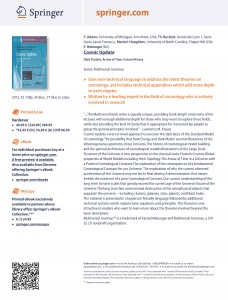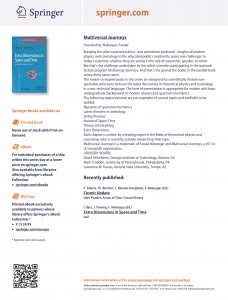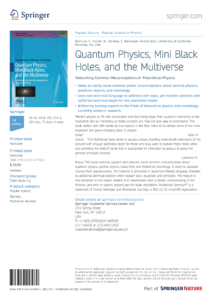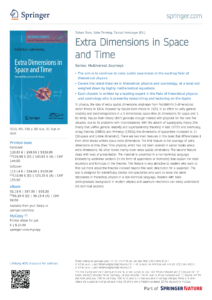
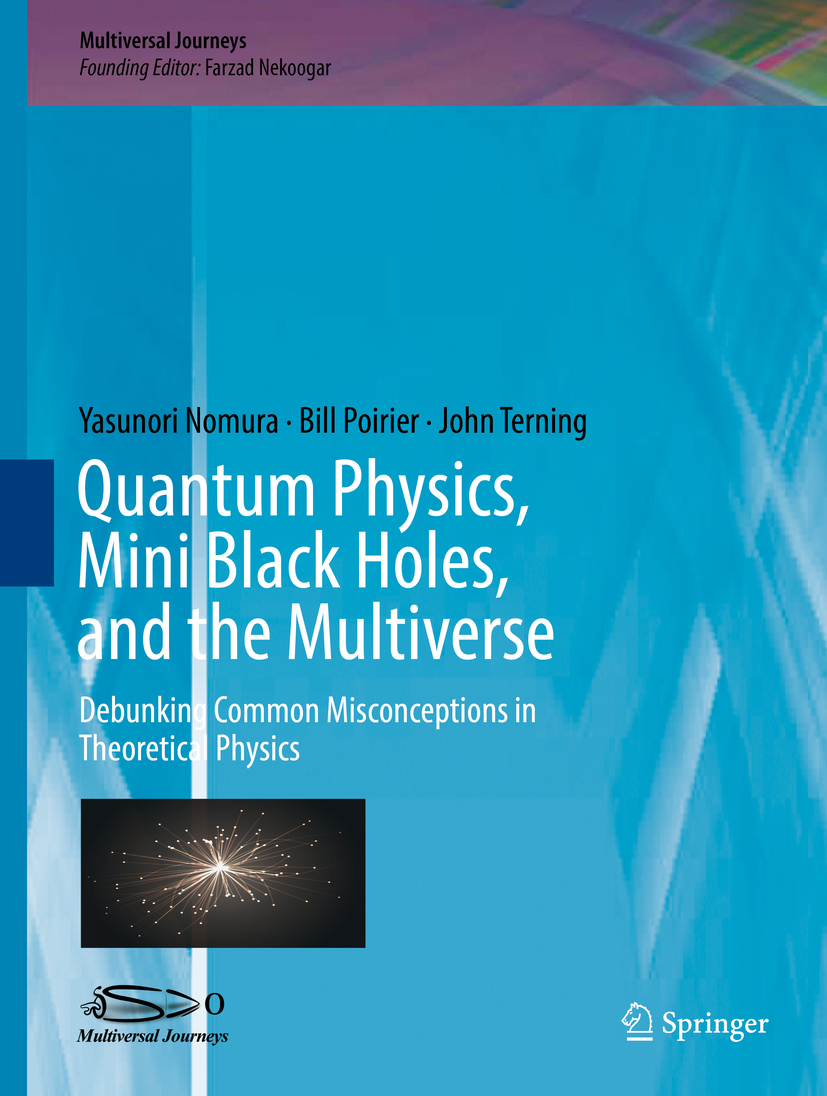
Quantum Physics, Mini Black Holes, and the Multiverse
Debunking Common Misconceptions in Theoretical Physics
Authors: Nomura, Yasunori, Poirier, Bill, Terning, John
Editors: Nekoogar, Farzad (Ed.)

Cosmic Update
Dark Puzzles. Arrow of Time. Future History
Adams, Fred, Buchert, Thomas, Mersini-Houghton, Laura, Nekoogar, Farzad (Founding Ed.) ISBN 978-1-4419-8293-3.

Extra Dimensions in Space and Time
Bars, Itzhak, Terning, John, Nekoogar, Farzad (Founding Ed.) 2010, ISBN 978-0-387-77637-8.
The meant-to-inspire books in this series are designed for scientifically literate non-specialists who want to know the latest discoveries in theoretical physics and cosmology in a non-technical language. The level of presentation is appropriate for readers with basic undergraduate background in modern physics and quantum mechanics.
More About the book series
Advisory Board:
Thomas Buchert, Université Claude Bernard, Lyon, France
Lawrence M. Krauss, Arizona State University, Tempe, AZ
Mark Trodden, University of Pennsylvania, Philadelphia, PA
TOPICS COVERED IN THE SERIES INCLUDE
- Extra Dimensions in Space and Time
- Cosmic Update – Dark Puzzles. Arrow of Time. Future History
- Mysteries of quantum mechanics
- String theories
- Nature of space and time
- Theory of everything
- Quantum Physics, Mini Black Holes, and the Multiverse
Each chapter is written by a leading expert in the fields of theoretical physics and cosmology who is currently actively researching their topic.
Book reviews
“Modern physics is rife with provocative and fascinating ideas, from quantum mechanics to the multiverse. But as interesting as these concepts are, they are also easy to understand. This book, written with deft hands by true experts in the field, helps to illuminate some of the most important and game-changing ideas in physics today.”
-Sean M. Carroll
“…The Multiversal book series is equally unique, providing book-length extensions of the lectures with enough additional depth for those who truly want to explore these fields, while also providing the kind of clarity that is appropriate for interested lay people to grasp the general principles involved.”
-Lawrence M. Krauss
“This book stands above others in its genre of physics books for laypeople. The subtitle promises that commonly held fallacies about popular topics in physics will be clarified. … Topics covered include basic quantum mechanics, relativity theory, and particle physics. … Highly recommended. All levels/libraries.”
(A. Spero, Choice, Vol. 56 (02), October, 2018)
“Popular expositions of scientific topics have an important role in informing the general public of the nature/implications of current research. This is always a difficult task, especially for the highly abstract and very complicated topics addressed here. … Summing Up: Recommended. Upper-division undergraduates and graduate students.”
(M. Coplan, Choice, Vol. 48 (2), October, 2010)
“The origin of this book lies in two public lectures given by the authors for a general public, under the auspices of multiversal journeys, a non-profit organization dedicated to disseminating knowledge on current theoretical physics to the general public. … It certainly is to be welcomed that leading theoretical physicists make an effort to communicate their research to the general public. This book demonstrates how to succeed in such an endeavour.”
(Michael Kunzinger, Zentralblatt MATH, Vol. 1207, 2011)
“The many ambitious aims of this book are: A noval approach to uncover the dark faces of the Standard Model of Cosmology. To present the global properties of World Models and their topology. To explain the arrow of time in a Universe with a positive cosmological constant Lambda and the consequences of Lambda for our Universe. … Graduate students in physics with interest in astrophysics and cosmology can use the book … . The Glossary is helpful for the beginner.”
(Johannes Viktor Feitzinger, Zentralblatt MATH, Vol. 1241, 2012)
“This book is a collection of three self-contained main contributions and an appendix, each from different authors, on current fundamental questions and new developments in cosmology. It is so structured that general readers can also follow the main ideas. The two longest chapters (written by Fred C. Adams and Thomas Buchert, respectively) contain appendices (at the level of an undergraduate textbook) with formulas specifying the basic descriptions.”
(Wolfgang Hasse, Mathematical Reviews, January, 2013)

